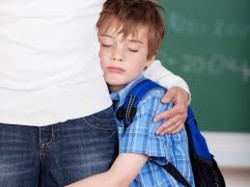Signs and Symptoms of Separation Anxiety
Separation Anxiety is an anxious reaction when a person or object of importance is removed even temporarily. Although considered a normal stage of child development, there are times when separation anxiety becomes so severe doctors consider it a disorder.
According to The University of Rochester Medical Center, normal separation anxiety occurs between seven and eleven months of age and resolves itself. There is however, a point where separation anxiety becomes separation anxiety disorder. This is a persistent fear of separation from a loved one. It is important to recognize the signs and symptoms of both normal separation anxiety and separation anxiety disorder.
We can help you find separation anxiety treatment. Call 888-647-0051 (Who Answers?) toll free anytime.
Signs of normal separation anxiety

It is common for parents to recognize a child’s separation worries when they first go to school.
The signs of normal separation anxiety usually occur early in life but can persist up to two years. The symptoms of normal separation anxiety are:
- Extreme distress – usually when a primary caregiver is not present. This can last until the caregiver comes back or may only last a few minutes.
- Tantrums – these tantrums include begging, crying, and whining
- Physical symptoms – complaining of stomach aches or headaches when it is time to go somewhere.
- Reluctance to go places even familiar ones – this is a fear that the caregiver will leave the child whenever they go out.
- Nightmares – the fear of permanent separation from a caregiver or family creates nightmares.
- Reluctance to go to sleep – many people believe this is just a tantrum behavior but it can be a sign of separation anxiety as well.
All of these symptoms usually go away gradually as a child continues to mature. It is when these symptoms persist that separation anxiety doctors consider it a disorder.
Signs of separation anxiety disorder
Separation anxiety disorder occurs after a trauma, along with another illness, or without any predicating factor. Although the signs of separation anxiety disorder are similar to normal separation anxiety there are some subtle differences. Some of the differences are simply that the behavior is excessive; others are due to the age of the sufferer. The signs of separation anxiety disorder include:
- Nightmares about being separated from a caregiver, pet, or loved one
- Not wanting or outright refusal to sleep alone
- Excessive clinging to caregiver, object, pet, or family member
- Frequent physical complaints such as muscle aches, headache, stomach ailments, and fatigue
- Constant concerns for safety or fearing something bad will happen to themselves or the caregiver
- Refusal to go to places including new and familiar places
- Worrying about being lost, getting lost, or being kidnapped
- Fear of being left alone or alone with strangers
- Excessive social anxiety
- Hiding while around others, usually hiding behind a caregiver or family member
These symptoms continue well beyond the age they should in a normal child. Patients experience these signs at any age and developmental stage even as an adult. Some people have a higher risk of separation anxiety disorder. By recognizing the signs of anxiety disorder doctors can diagnose it correctly.
Call 888-647-0051 (Who Answers?) toll free for help finding treatment.
Who is at risk for separation anxiety disorder?
There are social, event, and mental signs that indicate a person is at risk or is suffering from separation anxiety disorder. These signs are:
- Trauma or a traumatic event that serves as a trigger for separation anxiety
- Isolation and agoraphobia, are a good indicator that someone is suffering from separation anxiety or could be at risk for developing it.
- A previous diagnosis of mental illness
- Unfounded attachments to or clinging to family, friends, caregivers, pets, or objects
- Unusual excessive attachments to objects or pets to the point that the sufferer does not want to leave them at all
- Over anxious or over protective parents or spouses
- Other symptoms of separation anxiety persisting after the age of two
- Extreme jealousy of siblings, friends, and pets
- Relationship difficulties such as being stuck in dead end, abusive, destructive, or co-dependent relationships
- Worst case scenario thinking or focusing on “what ifs”
- Anxiety causing difficulty with relationships – when a person is too attached to parent or spouse they may not seek out normal healthy friendships and typical relationships.
According to the National Institute of Health, early childhood separation anxiety disorder is a risk factor for adult separation anxiety disorders as well as other anxiety spectrum disorders. Many symptoms of separation anxiety also mirror those of other anxiety disorders. A few related anxiety disorders include:
- agoraphobia,
- social anxiety,
- generalized anxiety disorder or GAD,
- post traumatic stress disorder or PTSD,
- panic disorder, and
- depression.
It is also important to remember that separation anxiety is not strictly limited to separation from people. Sometimes in separation, anxiety disorder the sufferer is excessively attached to an object or a pet. In which case, the signs and symptoms of separation anxiety disorder present themselves when the person is separated from the object or pet.
Separation anxiety disorder is also not limited to humans. Pets, particularly dogs, are known to suffer from separation anxiety disorder.
When to seek treatment
Most people worry about separation anxiety disorder when their children are going through a normal stage of early life. Knowing the difference between normal separation anxiety and separation anxiety disorder saves time and a trip to the doctor. If the symptoms persist, have a severe negative impact, are excessive, or are accompanied by a traumatic event, it might be time to seek professional help. Call 888-647-0051 (Who Answers?) toll free for help finding the right treatment for you or your loved one.





